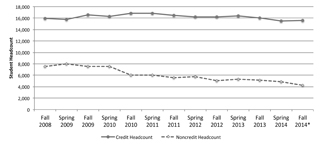Although the difficulty of finding parking may suggest otherwise, this semester’s enrollment figures suggest a preliminary decrease of 2.8 percent from last fall. Because these figures determine state funding, the school may face a financial setback.
“Even small decreases [in enrollment] can have a big effect on funding from the state,” said Edward Karpp, dean of research, planning, and grants.
The college’s enrollment rate has further declined since last year. In spring 2013, 16,428 credit students were enrolled, as opposed to the 15, 544 credit students this semester. However, Karpp believes that the numbers will become similar to last fall after the eight-week courses start, as more students are likely to enroll in these classes.
Mary Mirch, the vice president of instructional services, said that although declining enrollment is something the administration takes very seriously, the college is not “circling the drain,” meaning the enrollment figures are not yet detrimental despite the declining numbers.
Superintendent/president David Viar said the state expects colleges to grow about 2.5 percent; however, this kind of growth has been a problem for community colleges across the state for a variety of reasons, including budget cuts and a now-recovering economy.
“We have been affected by a number of factors, from the economy to budget cuts that occurred over the last few years that meant we had to cut back on courses and offerings,” said Viar.
According to Karpp, the economy plays a significant role in community college enrollment numbers. As the economy climbs out of recession, more jobs become available,
“When that happens, usually community college students are less likely to take college classes and they are more likely to get jobs,” he said.
Regulations regarding course repeatability also affect enrollment numbers. Students were once able to take recreational classes or repeat a class after getting a “W” and still qualify for financial aid. Now, however, the state has implemented regulations regarding students repeating classes, limiting their eligibility for financial aid. Mirch said this might be what is causing students to turn away from the college.
She also points to the fact that many students enroll at several different colleges simultaneously to take classes that were filled up or not offered at other campuses. This became the norm during the economic downturn of 2008, when GCC did not have the resources to provide enough classes to meet demand.
“Students learned to go to a variety of colleges to meet their needs and I think that is [something] they are used to now,” she said.
Some schools in Southern California, however, are actually showing an increase in enrollment.
According to Pasadena City College’s Crystal Kollross, director of institutional effectiveness, the school has 2,600 new credit students, which is a 10.8 percent increase from last fall. However, their non-credit student numbers are down.
Pierce College reported a similar increase. Doreen Clay, the college’s campus relations manager, said enrollment is up 4 percent from last fall.
According to the American Association of Community Colleges, nationwide enrollment has steadily decreased since 2011. However, both Mirch and Karpp agreed that many community colleges statewide are facing worse enrollment figures than Glendale College.
Mirch said that colleges can boost enrollment numbers by scheduling more classes at different times; however, because the times are spread out, there are more students overall but less enrolled per class, making the classes unprofitable.
According to Mirch, the point where a class pays for itself is when there are more than 24 students enrolled. Small classes are pricey and create statistics that do not necessarily mirror a college’s economic situation.
“We could grow if we were not paying any attention to the budget, but that is not a real world. We have to do both.” Mirch said .
In order to prevent declining enrollment while still ensuring that the college does not lose money, Mirch said the administration needs to analyze classes students are taking so that they can effectively schedule fewer classes with more students enrolled. This is a way to limit classes with only a few students.
GCC can thereby keep special classes in fields like biology and chemistry that are bound to have a smaller amount of students but still necessary for helping students transfer. Other actions include consulting with students and counselors and improve student success, and addressing what other problems might lead to students to study at another college.
Karpp explained that classes are being canceled every semester and that there are more classes offered this semester than the previous.
However, there are classes that are held back despite the fact that they are in demand. Administrative assistant of Credit ESL Luisa Salazar explained that there is a high demand for ESL level one classes. Several semesters ago, the college offered 13 sections of ESL level one classes; however, many ESL students left the campus once acquiring the basic English skills needed to get jobs, leading to low graduation statistics.
Because these statistics did not meet state standards funding was lowered, and the college had to limit their level one ESL courses to only seven per semester, which has created an impacted waiting list. Even though this demand has been prevalent in previous semesters, no courses have been added, causing many students to turn away from the college.
“We need more level one classes to help them get through the system,” said Kathleen Flynn, division chair and professor of credit ESL.
“Many of our students are not planning on going to college, they are planning to get a job. On Institute Day, Dr. Viar said that basic skills were a very important part of our college, so we would like to provide them at [ESL] level one.”
The school’s administration agrees that enrollment needs to be monitored and actions need to be taken to prevent further decline. However, this year enrollment figures are not the end of the line.
“We are concerned now, but it is not that serious,” said Karpp. “But it does mean a possible loss of funding at the end of the year.”


